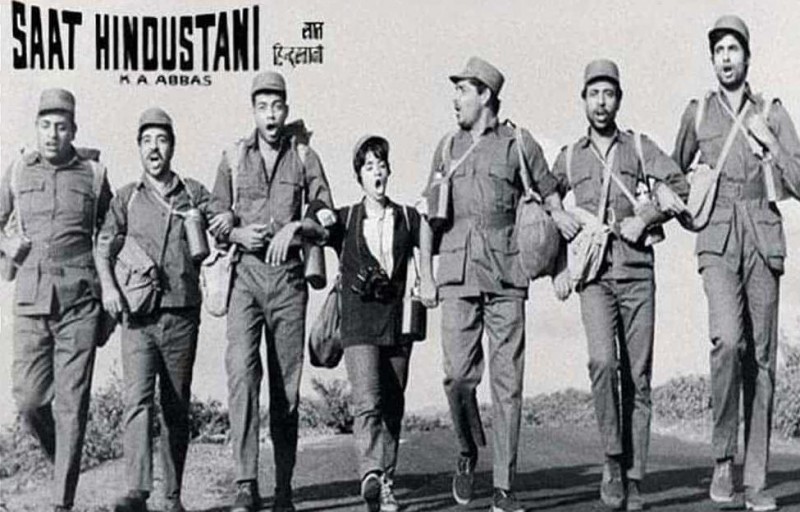
The Bollywood, or Indian film industry, is renowned for its grandeur and broad appeal. These days, the release of a movie is a carefully planned occasion with simultaneous premieres all around the nation. But in the early years of Indian cinema, the business was still getting established. With its initial release in Delhi and its subsequent release in Bombay a few months later, the 1969 film "Saat Hindustani" represents a pivotal point in the history of Indian cinema. The film's themes of identity and togetherness in a diverse and dynamic country were reflected in this unconventional release strategy, which went beyond simple practical considerations.
The legendary actor Amitabh Bachchan made his film debut in "Saat Hindustani," which was directed by Khwaja Ahmad Abbas. The 1960s social and political milieu in India gave rise to the film, which marked a significant departure from the mainstream Bollywood fare of the time. "Seven Indians" is the English title of the film, which pays homage to the seven individuals from disparate backgrounds who come together for a shared goal, signifying the diversity and unity that India embodies. The country's spirit and its continuous quest for identity were powerfully portrayed in the movie.
The Delhi premiere of "Saat Hindustani" took place on November 7, 1969. It was a calculated decision to have the movie's premiere in the country's capital. Delhi, the political hub of India, was a fitting location for the premiere of a movie meant to inspire a sense of solidarity and patriotism among the general public. The filmmakers were aware that Delhi's audience would be particularly receptive to the film's themes and content because of the city's close proximity to the political and historical centre of the country.
A number of well-known politicians and movie stars attended the lavish film premiere in Delhi. It provided a stage on which to emphasise the movie's message of national harmony, particularly in light of India's turbulent political climate in the late 1960s. The Delhi release provided the cast and crew with an opportunity to further their shared responsibility of fostering unity among the diverse Indian population.
The movie's makers held off on releasing it in Bombay (now known as Mumbai) for a few months after its initial release in Delhi. This choice was made with a strategic purpose in mind rather than just at random. In the context of movie releases, Mumbai, the centre of the Indian film industry, had a special significance. Mumbai audiences' reactions to a movie were frequently used as a gauge of that movie's quality.
A few months after the Delhi premiere, in March 1970, "Saat Hindustani" was released in Bombay. The film's unique approach and the cast's outstanding performances had already brought it a great deal of attention and praise by this point. Audiences eagerly awaited it, having heard about its triumph in Delhi.
It was a purposeful choice to premiere the movie in Bombay after first showing in Delhi. In order to concentrate on the film's central message of unity, the producers thought it would be best to release the movie in the political and administrative capital before moving it to the cultural and entertainment capital to realise its full commercial potential. The film was able to make waves throughout the country thanks to its dual release plan, from the halls of power to the core of Indian cinema.
"Saat Hindustani" was a statement rather than merely a film. The story of the movie revolved around seven heroes from various places and origins who band together to repel an alien invasion. Every character embodied a distinct aspect of India's multifarious cultures and regions. This was a novel idea during a time when most films followed a set plot.
The film's enduring characters, played by Madhu, Utpal Dutt, Amitabh Bachchan, and others, struck a chord with viewers all over India. The nation's history of colonialism and the hardships it had endured made the film's strong message of unity and celebration of diversity all the more pertinent.
It was astonishing to see Amitabh Bachchan in his first role as Goan Christian Anwar. It demonstrated his acting talent and laid the groundwork for his remarkable career. The film's soundtrack, which was composed by Khayyam and included the lovely song "Saat Hindustani," enhanced its allure.
"Saat Hindustani" had a huge influence. It not only succeeded in spreading the idea of unity in diversity that it set forth, but it also opened the door for Bollywood to tell more varied and socially conscious stories. It heralded in a new age of socially conscious and realistic storytelling in Indian cinema, as filmmakers delved deeper into themes beyond the traditional song-and-dance routines.
It was not merely a logistical decision to release "Saat Hindustani" in Delhi and Bombay, a few months apart. It was a calculated action meant to emphasise the movie's main point—which is that diversity can bring people together. The film's political and patriotic undertones were brought to light by its premiere in Delhi, the country's capital, and its commercial potential was demonstrated by its subsequent release in Bombay, India's entertainment capital.
Along with the film's compelling story, endearing characters, and catchy soundtrack, "Saat Hindustani" left a lasting impression on the Indian film industry thanks to its innovative release strategy. It paved the way for a new era in Bollywood by encouraging filmmakers to explore more diverse and socially relevant storytelling. "Saat Hindustani" is a timeless classic because its central message of identity and unity in a diverse nation is still relevant today, just as it was in 1969.
Why Anurag Kashyap's 'Ghoomketu' is a Testament to Shifting Film Industry Dynamics
Vicky Kaushal's Cinematic Debut in 'Luv Shuv Tey Chicken Khurana'
This lake is famous by the name of Madhuri Dixit! I will keep looking at the beauty